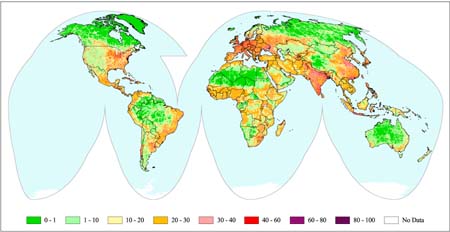This is according to a special study published this week based on satellite maps
Avi Blizovsky

Direct link to this page: https://www.hayadan.org.il/humanfootprint.html
Humans use 83 percent of the land surface for their needs to live, grow agricultural crops, cut or fish. In doing so, they raise a very limited area for the animals in the wild. This is according to a report published this week. Humans also use to their advantage 98 percent of the land that can be used to grow wheat rice or corn, according to the report prepared by the Wildlife Conservation Society (WCS) and the Columbia University Center for International Information on Earth Sciences (CIESIN) in New York.
Their map, published on the website http://www.wcs.org/humanfootprint, brings together the effects of population density, access to roads and waterways, electricity infrastructure, and the areas occupied by cities and patchwork applications.
Few remnants of wild life are found in the northern forests of Alaska, Canada, Russia, the high plains of Tibet and Mongolia and along most of the length of the Amazon River.
The human impact map clearly shows our impact on the planet," says Eric Sanderson, an ecologist at WCS who headed the team that prepared the report. "The map also shows a way to find opportunities to save wild animals and wild areas, as well as understand how it is possible to save what little nature there is in the prairies, villages, suburbs and big cities.
Antarctica and very few areas in the Arctic region were not included in the study due to the lack of information and the lack of human influence.
to the site where the map was published
https://www.hayadan.org.il/BuildaGate4/general2/data_card.php?Cat=~~~354537925~~~61&SiteName=hayadan
